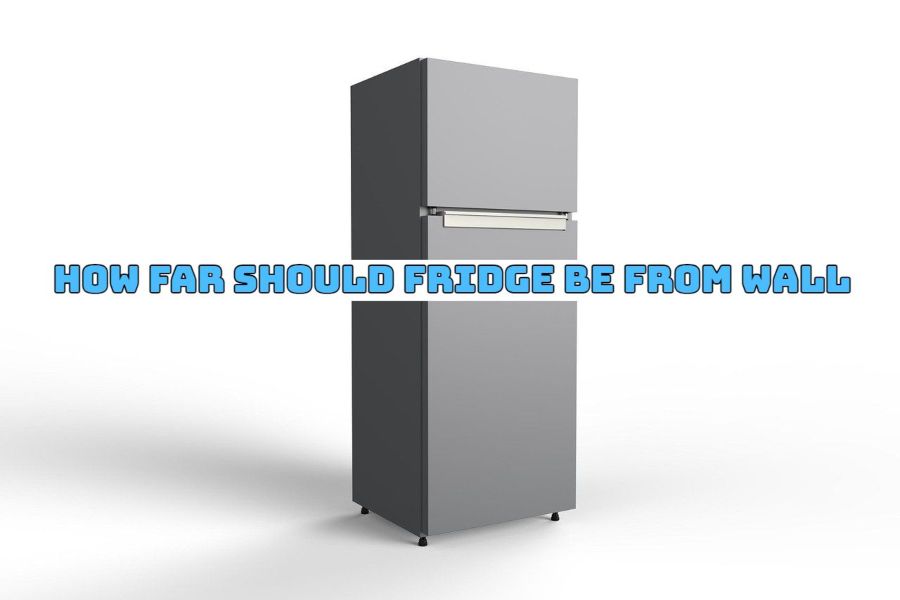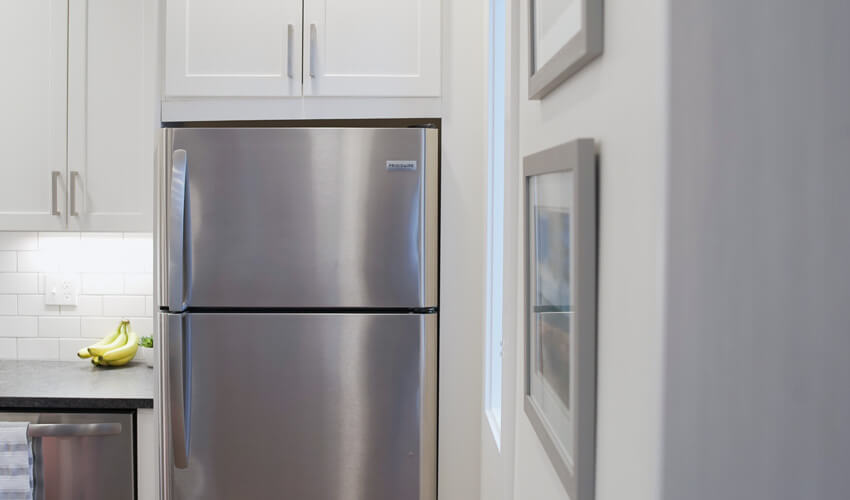
A fridge should be placed at least 1 inch away from the wall for proper air circulation. Specific models may require more space, so always check the manufacturer’s guidelines.
Ensuring proper spacing for your refrigerator is crucial for maintaining its efficiency and longevity. The gap between the appliance and the wall facilitates air flow, preventing the motor and coils from overheating. While a minimum distance of one inch is a standard recommendation, consulting the user manual for your particular fridge model can provide more precise instructions.
Proper positioning also allows for easy access to the back for cleaning and maintenance, helping to keep your kitchen safe and your appliance running smoothly. Adhering to these guidelines not only enhances your refrigerator’s performance but can also reduce energy consumption, ultimately saving on utility bills. Remember, the key to a well-functioning fridge is balance: sufficient space for air flow without wasting valuable kitchen area.

Credit: www.mrappliance.com
Why Fridge Clearance Matters
Knowing the right space to leave between a fridge and the wall is key. It keeps the fridge working well. A fridge too close to the wall may not cool properly. Let’s explore why proper clearance is a must.
Efficient Airflow
Good airflow keeps your fridge running smoothly. Air needs to move around the coils behind the fridge. This stops the motor from working too hard. Here’s what happens with enough space:
- Consistent temperature inside
- Lower electric bills
- Longer fridge life
Always check your fridge manual. It will tell you the exact space you need.
Preventing Overheating
A fridge too close to the wall may get too hot. This happens when heat can’t escape. When it overheats, here’s what could go wrong:
- Food may spoil faster
- Extra stress on components
- Possible breakdowns
Remember: Always leave sufficient space for cooling purposes. This prevents costly repairs.
Standard Spacing Recommendations
Setting up your kitchen requires understanding the standard spacing recommendations for appliances. Proper spacing ensures safety, functionality, and ease of maintenance. When it comes to refrigerators, enough space between the fridge and wall is crucial.
Manufacturer Guidelines
Manufacturer guidelines are the first place to look. Refrigerators need air to circulate around them. Each brand provides a manual with specific distances. These guidelines help appliances run efficiently. They prevent overheating and save on energy costs.
- Check your fridge’s manual for exact spacing.
- Follow these distances for safe operation.
- Keep vents unblocked to let your fridge “breathe”.
Typical Clearance Numbers
Typical clearance numbers vary slightly. Here’s a quick reference:
| Location | Minimum Space |
|---|---|
| Sides | 0.5-1 inch |
| Top | 1 inch |
| Back | 1-2 inches |
These spaces allow for air flow and easy cleaning. Sides give room for doors to open. The top space is for user convenience. Back clearance lets your fridge cool down.
Measuring The Right Distance
Ensuring proper ventilation for your refrigerator is crucial for peak performance. A suitable distance from the wall prevents overheating, promotes air circulation, and extends the fridge’s life. Let’s dive into how to measure that perfect gap.
Tools You’ll Need
Before you start, gather these items:
- Tape measure to determine the distance
- Level to ensure your fridge is perfectly horizontal
- User manual for custom recommendations
Step-by-step Process
Follow these steps to create enough space behind your fridge.
- Pull the fridge away from the wall. Be careful not to scratch the floor.
- Use the tape measure to check the gap. Aim for at least 1-2 inches.
- Consult the user manual. Some models need more space.
- Check for levelness. Adjust the feet if needed.
- Slide the fridge back. Maintain the measured distance.
Credit: www.lg.com
Maximizing Kitchen Space While Maintaining Clearance
Kitchens need smart layouts to balance function and style. It’s not just about aesthetics; it’s about the practical placement of your fridge. Ensuring your refrigerator is not too close to the wall prevents overheating and promotes air circulation. This saves energy and extends the lifespan of the appliance. Let’s dive into optimizing kitchen space and fridge placement.
Strategic Placement
Getting the distance right between your fridge and the wall boosts kitchen efficiency. Here’s a quick guide:
- Top and sides: At least 2 inches
- Back: Minimum 1 inch
- Door swing: Enough room for door to open fully
- Fridges with coils on the back need more space
This space prevents overheating and maintains airflow. It keeps your kitchen safe. Position your fridge to allow easy access. Keep it away from heat sources like ovens and dishwashers.
Custom Cabinetry Solutions
Custom cabinets create space and keep clearances in check. They fit around your fridge. This makes your kitchen look great. They use every inch smartly. Let’s look at some cool ideas:
| Idea | Benefit |
|---|---|
| Slide-out pantry | Easy access to goods |
| Over-fridge storage | Use vertical space |
| Built-in cubbies | Organize better |
Professional kitchen designers align fridge space and cabinetry neatly. This ensures proper clearance. It combines form and function.
Troubleshooting Common Spacing Issues
Placing a fridge right can be tricky. Problems may pop up. Let’s solve common spacing issues.
Adjusting For Uneven Walls
A fridge needs to stand straight. Uneven walls might cause a wobble or a gap. What to do?
- Use shims: Slide thin pieces of wood or plastic under the fridge to make it level.
- Adjust the feet: Most fridges have adjustable feet to help it stand even.
- Check with a level: Use a tool to make sure your fridge is not leaning.
Handling Limited Space
Small kitchens mean tight spaces. Your fridge still needs breathing room. Here’s a quick guide:
| Area | Space Needed |
|---|---|
| Top | 1 inch |
| Back | 2 inches |
| Sides | ½ inch |
To maximize space:
- Slide the fridge: Pull it forward slightly for better airflow at the back.
- Remove clutter: Keep the top clear. This helps heat escape.
- Install pull-outs: Sliding shelves make it easy to access the back.

Credit: www.forbes.com
Long-term Benefits Of Proper Fridge Placement
Placing your fridge correctly can do wonders over time. The right distance from the wall means your appliance works less hard. This lowers the chance of breakdowns. A happy fridge means happy you.
Extended Appliance Life
Enough space behind your fridge keeps it cool. It lets air flow well. This means your fridge doesn’t overheat. Overheating can break your fridge fast. Giving your fridge its space can make it last years longer. Think of it as giving your fridge a little “breathing room”.
Energy Savings
A fridge too close to the wall works too hard. This uses more power. Keep your fridge at the right distance, and it uses less electricity. Lower power bills and a happier planet go hand in hand with proper placement. Your wallet will thank you in the long run.
Frequently Asked Questions For How Far Should Fridge Be From Wall
How Close To A Wall Can You Put A Refrigerator?
Place your refrigerator at least 1 inch from the wall for adequate air circulation. This prevents overheating and promotes efficiency. Always check the manufacturer’s recommendations for optimal spacing.
How Much Space Do You Need Behind A Refrigerator?
Leave at least one inch of space behind your refrigerator for proper airflow. This helps ensure efficient operation and prolongs the appliance’s lifespan.
What Should Be The Distance Of The Refrigerator From The Wall?
The recommended distance between a refrigerator and the wall is at least 1 inch for proper airflow and functionality.
How Close Can A Fridge Be To A Corner?
A fridge should be at least 1 inch from a corner to allow for proper door swing and ventilation. Maintain sufficient space for airflow to ensure optimal appliance performance.
Conclusion
Ensuring your fridge has the proper clearance from the wall is essential for optimal performance. Aim for at least a one-inch gap to facilitate air circulation and maintain efficiency. Regular checks can prevent costly repairs and extend the lifespan of your appliance.
Prioritize this small but crucial step for a happy, healthy kitchen.




















